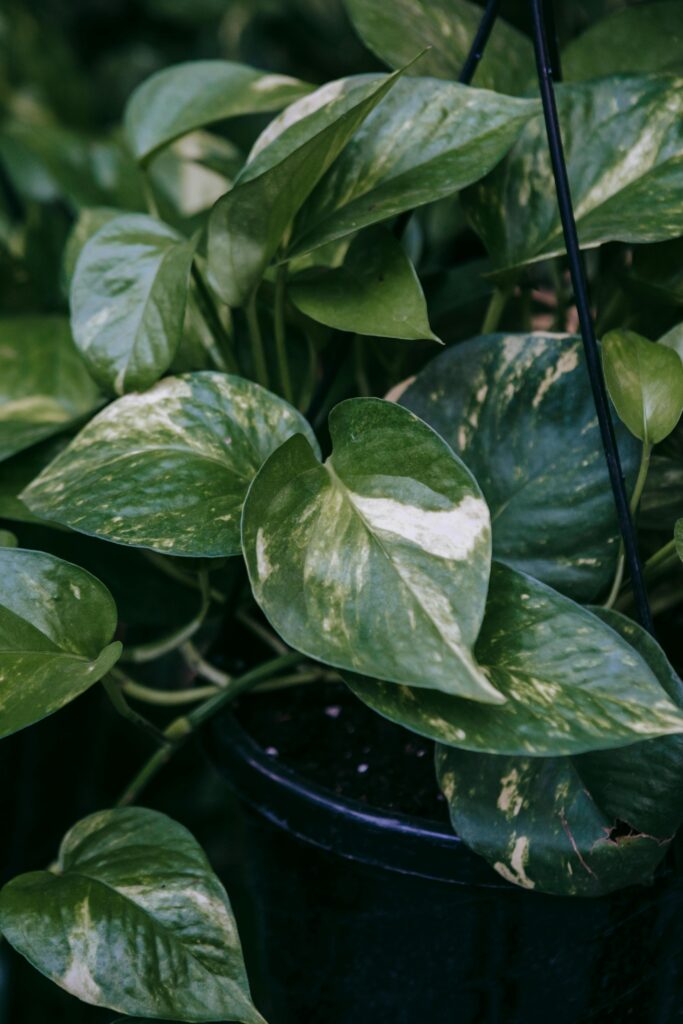Take It Easy – A Guide for Pothos

Let us introduce you to one of the easiest and most popular houseplants: the Pothos (Epipremnum aureum). Known for its trailing vines, heart-shaped leaves, and low-maintenance nature, the Pothos is a favorite among beginner and seasoned plant lovers alike. Whether you’re looking to add a splash of green to your space or brighten up a shelf, Pothos plants are incredibly adaptable, forgiving, and versatile. Here’s everything you need to know to keep your Pothos happy and thriving.
1. Lighting Needs
Pothos plants are incredibly versatile when it comes to light requirements. They can thrive in a variety of lighting conditions, from low to bright indirect light, making them a perfect addition to nearly any room in your home.
- Ideal Placement: Near east or west-facing windows where they receive bright, indirect light.
- Tolerable Conditions: Low light areas are fine for Pothos, but growth may slow, and variegated varieties might lose some of their variegation in low light.
Tip: If you notice slow growth or fading variegation on types like Golden Pothos or Marble Queen, try moving your plant to a slightly brighter spot.
2. Watering Routine
Pothos plants prefer a “drench and dry” watering approach, where you let the soil dry out partially between waterings. Overwatering is a common issue for Pothos, so it’s best to check the soil before each watering.
- Watering Frequency: Typically, water every 1-2 weeks, depending on your home’s humidity and light conditions. Let the top 1-2 inches of soil dry out before watering.
- Method: Water thoroughly until excess drains out of the bottom of the pot, then empty the saucer to avoid root rot.
Tip: Drooping leaves are often a sign that your Pothos is either thirsty or overwatered. Check the soil to confirm the cause before watering.
3. Humidity and Temperature Requirements
Pothos plants are tropical by nature, so they prefer a humid environment but are adaptable to average household humidity levels. They can tolerate a wide range of temperatures, making them easy to care for in most indoor environments.
- Optimal Humidity: Around 50%, though they’ll do fine in normal household humidity.
- Temperature Range: 65-85°F (18-29°C), but keep them away from drafts or sudden temperature drops, which can cause leaf yellowing.
4. Ideal Soil Mix
A well-draining potting mix is key to keeping your Pothos healthy. They don’t like to sit in soggy soil, so a lightweight, aerated soil mix works best.
- Recommended Mix: Use a standard indoor potting mix with added perlite or orchid bark for better drainage.
- Pot Type: Choose a pot with drainage holes to prevent water from accumulating in the soil.
Tip: If your Pothos seems to be holding too much moisture, consider repotting with a more well-draining soil mix to keep roots healthy.
5. Fertilizing Tips
Pothos plants don’t require heavy feeding, but they can benefit from occasional fertilization, especially during the growing season.
- Fertilizer Type: Use a balanced, water-soluble fertilizer diluted to half strength.
- Fertilizing Schedule: Feed every 6-8 weeks during spring and summer. Reduce feeding during fall and winter when growth slows.
Tip: Avoid over-fertilizing, as this can lead to salt buildup in the soil. A gentle rinse of the soil every few months can help flush out any residual salts.
6. Pruning and Propagation
Pothos are fast growers, and regular pruning helps maintain a full, bushy shape. It’s also easy to propagate them, so you can grow new plants from stem cuttings.
- Pruning: Trim back any leggy vines or yellow leaves with clean scissors to encourage fuller growth.
- Propagation: Pothos cuttings root easily in water. Simply cut a vine just below a node (the spot where a leaf attaches), remove the bottom leaves, and place the cutting in a jar of water. Once roots form, you can transfer it to soil.
Tip: For a bushier plant, regularly pinch back the tips of vines to encourage branching.
7. Popular Varieties and Their Unique Care Needs
Pothos plants come in various colors and patterns, with some needing a bit more light to maintain their unique variegation.
- Golden Pothos: Known for its green and yellow variegated leaves, Golden Pothos can tolerate low light but will show more vibrant colors in medium to bright indirect light.
- Marble Queen Pothos: This variety has striking white and green marbled leaves and prefers brighter indirect light to maintain its variegation.
- Neon Pothos: With its bright, chartreuse leaves, Neon Pothos adds a splash of color and thrives in medium to bright indirect light, where its color is most vibrant.
Tip: Variegated Pothos types may lose some of their color patterns in low light, so move them to brighter spots if you notice a reduction in their unique patterns.
8. Common Problems and Solutions
While Pothos plants are quite resilient, here are a few common issues and how to address them:
- Yellow Leaves: Often caused by overwatering. Let the soil dry out more between waterings and check for proper drainage.
- Brown Leaf Tips: May indicate low humidity or dry air. Increase humidity by misting or moving your Pothos to a more humid area.
- Pests: Occasionally, Pothos can attract pests like spider mites or mealybugs. Wipe leaves with a damp cloth and treat with insecticidal soap if necessary.
Pothos plants are forgiving, easy to care for, and incredibly adaptable, making them a great choice for any indoor plant collection. With these tips, your Pothos will continue to flourish, adding lush greenery to your home for years to come. For more plant care insights and to explore our range of Pothos varieties and other unique plants, visit us at ArtisticFoliage.com. Happy planting!
